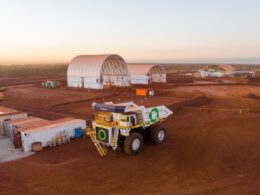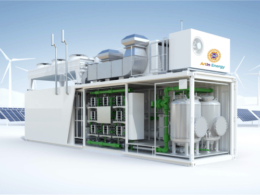On the Vancouver set of its popular show ‘Virgin River’, Netflix is experimenting with greener alternatives to traditional film production. The popular drama series, like other Netflix shows, is replacing diesel generators with massive battery-powered lights as part of the company’s broader effort to cut emissions by half by 2030. Shows like Stranger Things and Bridgerton are also exploring sustainable energy solutions, such as solar-powered trailers and hydrogen units.
On the sets of Virgin River, the fake sunlight is produced by combining the power of two massive 18,000-watt lights running on a giant battery, which has replaced the traditional generators that use fossil fuels.
These steps are part of Netflix’s plans to reduce emissions in half by 2030. Despite these initiatives, Netflix’s overall progress in reducing emissions has been slow since launching its sustainability focus in 2020. Emissions increased in 2022 compared to 2019, with recent drops attributed to industry-wide work stoppages.
Netflix’s sustainability officer, Emma Stewart, explains the challenges, including limited direct control over equipment and studio spaces.
Film and TV production are critical areas for Netflix to address, as they account for more than half of the company’s emissions. Outside of its Albuquerque studio—where Netflix has invested in geothermal water loops, solar power, battery storage, and EV fast chargers—the company typically doesn’t own the equipment or studio space used in its productions. While Netflix could enforce emissions-reducing practices among its vendors, landlords, and production partners, sustainability officer Emma Stewart believes in using incentives, or “creating carrots that we think are as big as sticks”, she says.
The film industry, since its early days, has developed a vast, decentralised network of local vendors providing specialised gear like lights, cameras, trucks, and generators. Getting these various suppliers to adopt greener practices is challenging, even with strong incentives.
However, if Netflix can encourage its suppliers to invest in low-emissions equipment, it could lead to widespread industry change. Netflix’s emissions are similar to its peers, and many of its vendors serve multiple studios. This means that when Netflix adopts greener technologies, it benefits the entire industry. By signaling demand for low-emissions gear, Netflix can help reduce the financial risk for suppliers, driving broader adoption across the sector.
Achieving this would be a significant accomplishment. While the entertainment industry’s carbon footprint is relatively small compared to more emissions-heavy sectors like technology and aviation, its societal influence is far-reaching. Hollywood’s impact on shaping societal values and norms is immense, and it has the potential to drive a broader shift in how businesses prioritize sustainability.
Netflix uses tools such as renewable energy certificates (RECs) and carbon credits, which have been debated in terms of effectiveness, to support its sustainability claims as it gradually expands initiatives like those on the Virgin River set.
Hunter Vaughan, a University of Cambridge researcher and the author of Hollywood’s Dirtiest Secret said, “Getting the shot is still paramount, and that’s often not an environmentally efficient or responsible way to approach it. Without challenging these ideological foundations, the real positive change isn’t going to happen.”
On the Virgin River set, while most are unaware of the ongoing energy transition, Jeff Harvey is at the center of it. As the rigging gaffer, responsible for power and lighting, Harvey now takes on more of a logistics role. He creates detailed “battle plans” outlining where each battery needs to go, when it must be in place, and what it will power, taking charging times into account. “We spend a little less time on setting up, and I spend more time on the front end organising,” Harvey explains.
Rob Fairbridge, the transportation coordinator, faces similar challenges. Managing a fleet of electric cars and trucks, he test-drives each vehicle for two weeks before filming starts to anticipate potential issues. He notes that vehicles charge more slowly as they near full capacity, so drivers must plan for that extra time.
Crews also face major supply issues. In Vancouver, where the show is filmed, there are only seven large production-ready batteries, while up to 50 productions can be shooting in the city at any time. To secure the necessary green equipment and outpace the competition, Netflix reserved all the clean tech required for Virgin River’s Season 6 months in advance, an unusually proactive step. A week before filming, another local production pleaded with Harvey for one of his batteries, and he only agreed because he had reserved extra.
While decarbonising film and TV production is the most visible effort, it has been a relatively small part of Netflix’s overall emissions reduction strategy. In 2022, electric or hybrid vehicles and clean mobile power—such as batteries and hydrogen systems—accounted for 5% of the company’s avoided emissions, dropping to 2% in 2023.
The majority of Netflix’s emissions reductions have come from purchasing renewable energy, either through landlords or directly from utilities via green tariff programmes. However, this process is more complex than it seems. Green tariff programmes allow large utility customers to pay for renewable energy from specific projects, like solar farms. Although the specifics vary by region, the main goal is to help customers achieve their energy targets while reducing the financial risks for utilities building new renewable projects. According to Stewart, Netflix pays a premium to participate in these programmes.
“Since Netflix currently only owns one studio property globally, and is a relatively small electricity user in any location, we don’t typically invest in onsite renewable energy projects, instead paying a premium to opt into certain utility green tariff programs,” a company spokesperson said.
To offset the emissions it cannot eliminate or reduce, Netflix purchases carbon credits. In 2021 and 2022, the company bought over a million credits, though that number dropped to just over 800,000 last year. The company follows a similar approach with its non-renewable electricity usage by purchasing renewable energy credits (RECs).
Netflix’s impact on the industry is significant. Since its beginnings in 1997 as a DVD rental service, the company has transformed the entertainment landscape. Today, it accounts for about 8% of TV viewership in the US and is a dominant player in many major markets worldwide. With an estimated audience of over half a billion, Netflix is on track to generate nearly $40 billion in revenue this year.





















